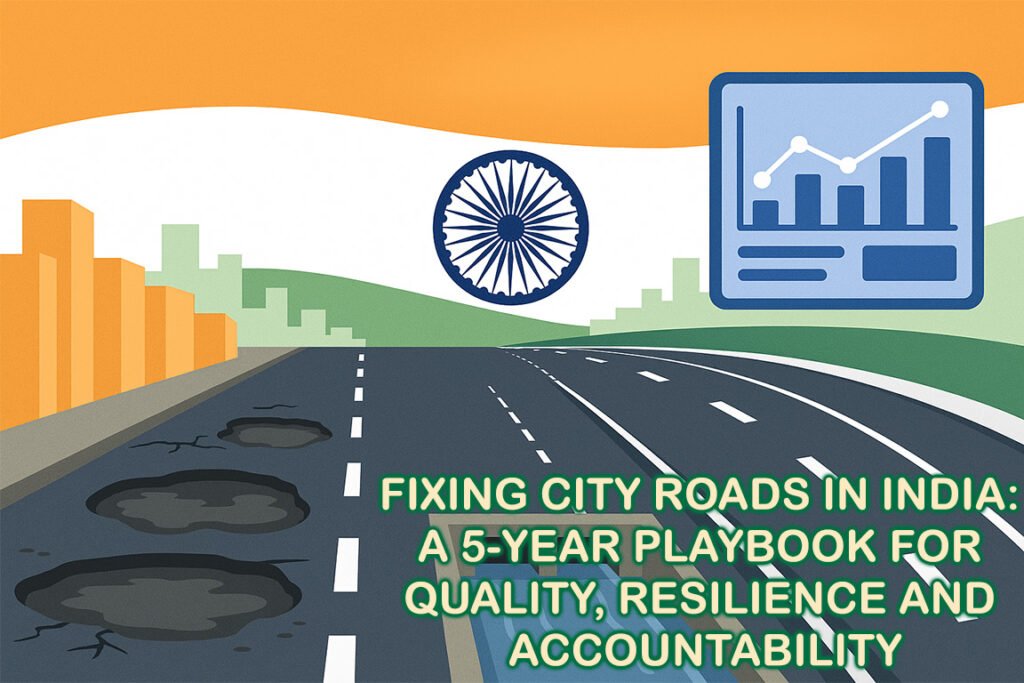
Fixing City Roads in India: A 5-Year Playbook for Quality, Resilience, and Accountability
India’s city roads are notorious for potholes, waterlogging, and premature breakdowns. Weak standards, poor drainage, and short-term contracts keep cities stuck in a cycle of “build-break-repeat.” This policy brief proposes a five-year program combining national frameworks and city-level execution to improve road quality, accountability, and resilience.
Problem Diagnosis
Urban road failures in India stem from systemic issues: poor drainage integration, contractor incentives for short-term work, fragmented accountability, underfunded maintenance, and lack of condition data. Fixing these requires not just more money, but smarter systems and long-term approaches.
What Works Globally
- Performance-based maintenance contracts (PBMC): Contractors are paid for road quality and uptime, not just asphalt quantities.
- Pavement Management Systems (PMS): Data-driven planning prioritises preventive maintenance over expensive reconstruction.
- Utility coordination codes: Standards for trenching and reinstatement, as in the UK, reduce road failures.
- Climate-resilient pavements: Concrete roads, high-modulus asphalt, and better drainage mitigate flood damage.
Indian Reference Points
India already has success stories to scale: long-tenure O&M contracts in select cities, concrete arterial roads in Mumbai and Gujarat, TenderSURE corridors with integrated utilities, and waste-plastic modified bitumen in Tamil Nadu and Pune. These pilots show that better procurement and materials can deliver longer-lasting roads.
The 5-Year Program
A. National Framework
– Launch a National Urban Road Mission (NURM-R) with central matching grants for cities adopting PBMCs and PMS. – Refresh standards via IRC to mandate integrated road–drainage–utility designs. – Publish a model PBMC document with KPIs and payment terms. – Create a national urban road atlas with condition data.
B. State Actions
– Establish State Urban Road Maintenance Funds with dedicated yearly allocations. – Build independent quality labs for materials testing and audits. – Introduce a utility coordination code with reinstatement guarantees.
C. City Execution
- Deploy Pavement Management Systems to monitor condition (PCI/IRI).
- Cluster 100–200 km of roads into PBMCs with 5–7 year tenures.
- Integrate drainage into every road design.
- Use appropriate materials: concrete for heavy traffic zones, SMA/high-modulus asphalt for arterials, micro-surfacing for preventive care.
- Construct common utility ducts; enforce “no-cut” policies on new roads.
- Launch citizen-facing pothole apps with SLA-based closure times.
- Build dashboards showing road condition, pothole response times, and contractor performance.
Money and Governance
Funding should shift to lifecycle models—2–3% of replacement value annually for O&M. Central matching grants, state road funds, and municipal bonds can support this. Governance reforms include creating “One Road Offices” in cities, third-party audits, and training programs for urban pavement engineers.
KPIs and Quick Wins
- KPIs: International Roughness Index (IRI), pothole turn-around time, drain uptime during monsoons, crash reduction, and citizen satisfaction scores.
- Quick wins: monsoon readiness audits, pothole SLA dashboards, PBMC pilots, and trenchless utility work mandates.
Conclusion
Quality roads are not more expensive—they are better procured and better maintained. By adopting PBMCs, PMS-led planning, climate-resilient design, and open dashboards, Indian cities can escape the cycle of poor roads within a single political term. A shift from “build-break-repeat” to “maintain well, pay for performance” will transform urban mobility and citizen trust.